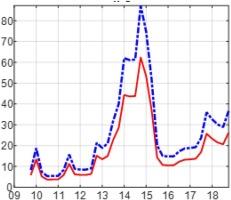Measuring the deadly embrace: Systemic and sovereign risks |
| |
| Affiliation: | Luxembourg School of Finance/Sacred Heart University, Luxembourg |
| |
| Abstract: | 
This study contributes to the literature by making a first step toward implementing a comprehensive internally coherent measurement of systemic risk in a country. It measures systemic risk and the ensuing conditional contingent liabilities of the sovereign stemming from Luxembourg’s Other Systemically Important Institutions (OSIIs), the Global Systemically Important Banks (G-SIBs) to which they belong, the investment funds sponsored by the OSIIs, the household and the non-financial corporate sectors. The ensuing estimated systemic contingent claims are included in a stochastic version of the general government’s balance sheet to gauge their impact on the country’s sovereign risk. Results indicate that time-varying conditional implicit guarantees from OSSIs are larger than those from G-SIBs and investment funds, while systemic risk stemming from the household and non-financial corporate sectors is moderate. The robustness of the sovereign is not drastically affected by systemic risk stemming from the rest of the economy. However, illustrating the so-called “deadly embrace”, sovereign risk would significantly rise as a result of a historically plausible increase in sovereign assets’ value volatility combined with an economy-wide shock. The main policy implication is that financial stability stands on two columns, a resilient financial sector and a sustainable fiscal position. |
| |
| Keywords: | Financial stability Macroprudential policy Banking sector Investment funds Sovereign risk Non-linearities |
| 本文献已被 ScienceDirect 等数据库收录! |
|

